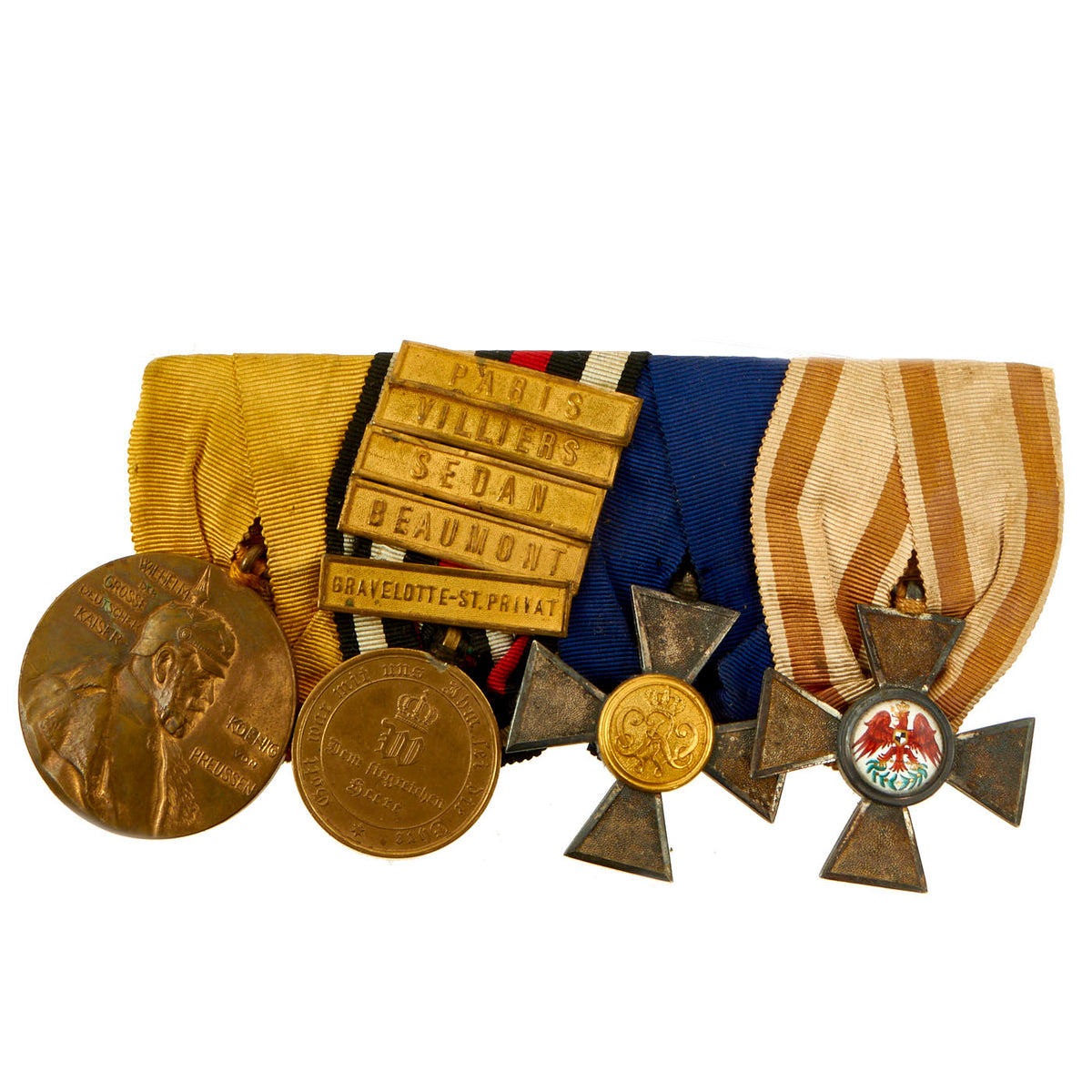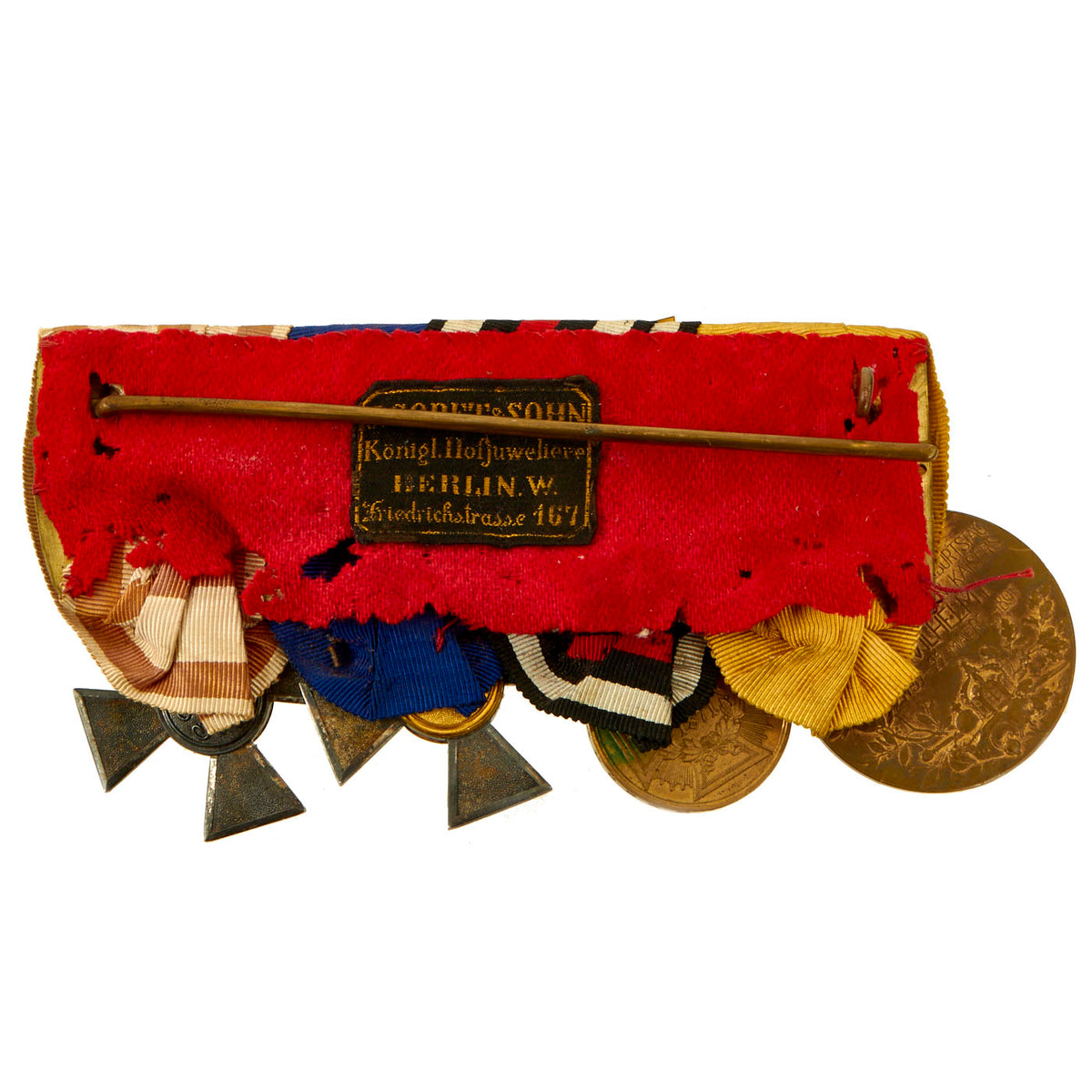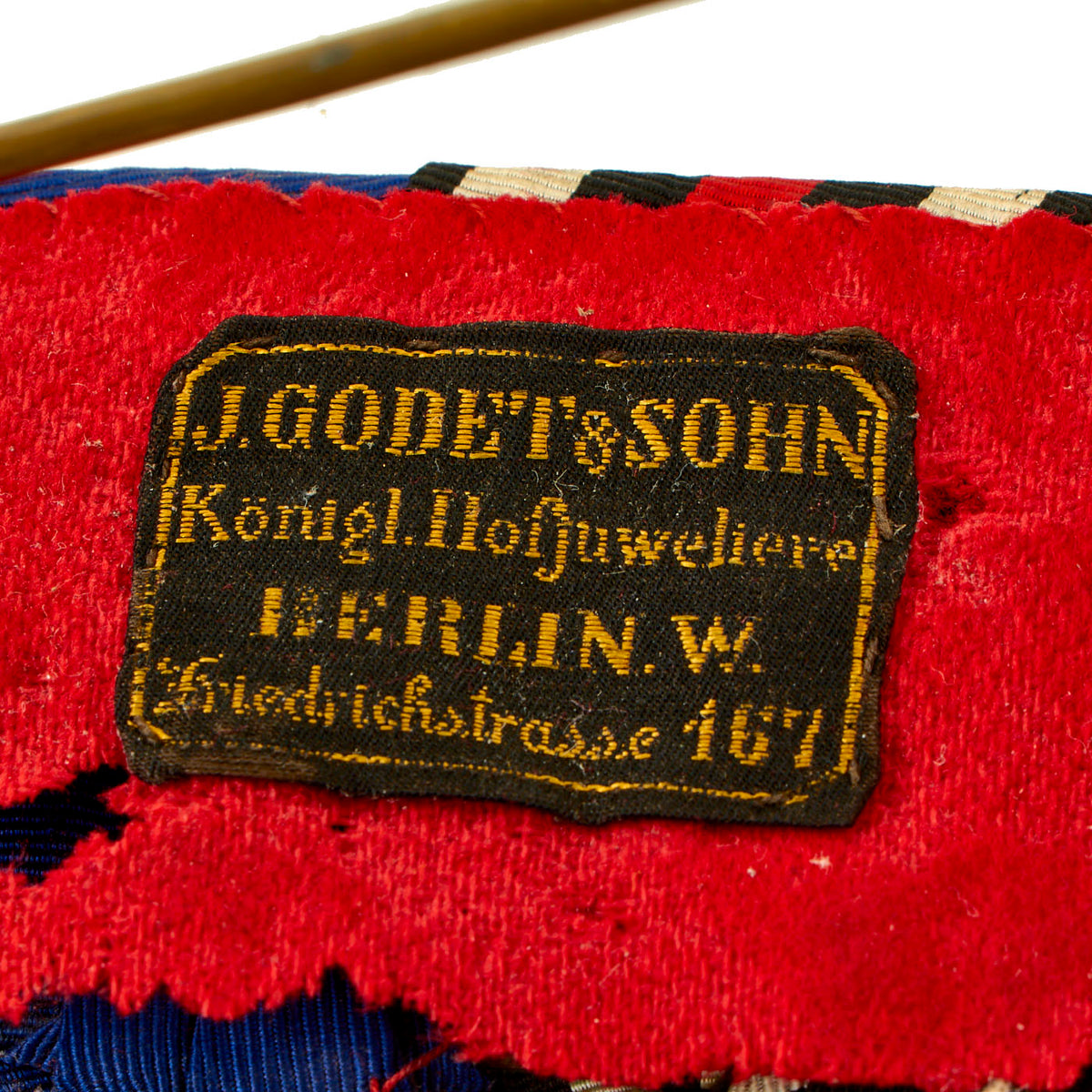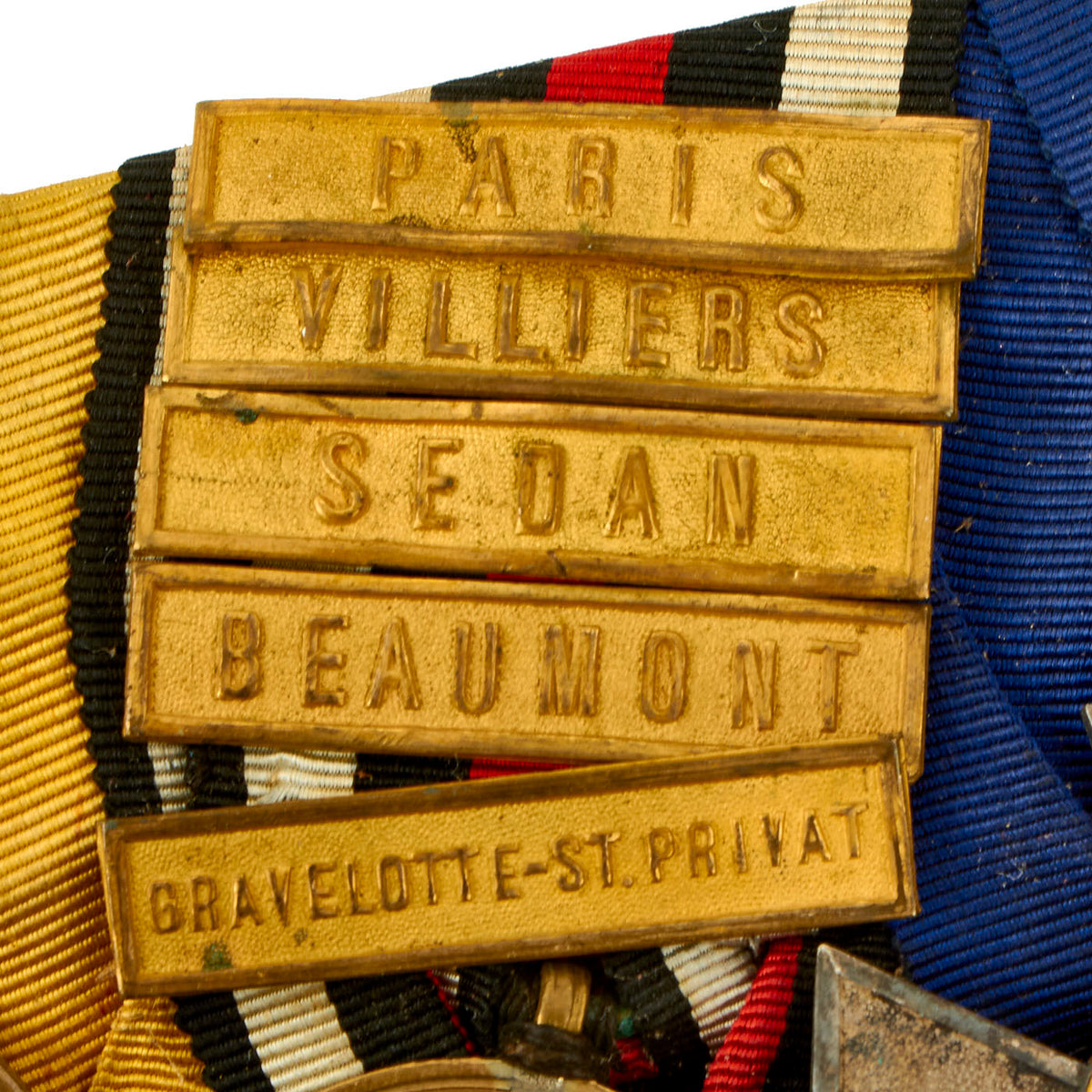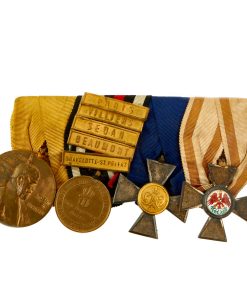Original German Pre WWI Franco-Prussian War Veteran Medal Bar Featuring Order of the Red Eagle 4th Class – by J. Godet & Sohn – 4 Awards Original Items
$ 895,00 $ 223,75
Original Item: Only One Available. This is a very nice 4 medal bar which was assembled by the prestigious firm of J. Godet & Sohn of Königliche Hofjuweliere, Berlin. This is the oldest order/jewelry firm in Germany, known for making every German order and insignia from around the world. It was founded by Jean Godet in 1761, and was first located at Schloßfreiheit 4 in Berlin. Around 1796, it was taken over by his son, Jean Jacques who was later succeeded by his son, Jean Frederic. Under his stewardship, the firm became the official court jeweler to the Crown Prince of Prussia in 1828. In 1861, King Wilhelm designated Godet, then run by Jean Fredric’s son Jean Pierre, the official purveyor to the court. In 1871, the German Empire was born with Kaiser Wilhelm on the throne. It is believed that Godet was manufacturing the “Type B” core of the Iron Cross at this time, along with both the first and second class Iron Cross, and international orders. In 1880, Pierre died, and six years later, Eugen Godet entered the family business. They moved locations in 1892 to Friedrichstraße 167, and again in 1908 to Charlottenstraße 55. In 1911, the firm was designated the Royal Court Jewellers by Kaiser Wilhelm II during their sesquicentennial celebrations, the highest honor a jeweler could receive. Eugen became the sole proprietor at the age of 45 that same year, the fifth generation of Godet. The company was also the court jeweler to the Grand Duke of Mecklenburg-Schwerin and to the Prince of Lippe.
The Medals Present on this Bar:
– Kaiser Wilhelm Memorial Medal: The Kaiser Wilhelm Memorial Medal was established on March 22, 1897 by Wilhelm II to celebrate the 100th Birthday of his grandfather, Emperor Wilhelm I. The Centenary Medal was awarded by Prussia to state and university officials, as well as all military officers, non-commissioned officers and enlisted personnel, who had been actively serving in army, navy and Schutztruppe. Medals were also awarded to the surviving veterans of the First Schleswig War, Second Schleswig War, Austro-Prussian War, and the Franco-Prussian War.
The Centenary Medal is made of struck bronze gunmetal from captured cannons. It measures 40 mm in diameter and is suspended from a ribbon 36 mm wide. The obverse depicts a right facing effigy of Wilhelm I in military uniform wearing a mantle and Pickelhaube. To the left of the effigy is the inscription WILHELM / DER / GROSSE / DEUTSCHE / KAISER (William the Great German Emperor). To the right is KOENIG / VON / PREUSSEN (King of Prussia).
The reverse of the medal shows symbols of royal authority including the German State Crown, an orb, sword, and scepter placed upon a pillow surrounded by oak leaves, in the lower half of the medal. To the left is an upward climbing laurel branch. In the upper half is the inscription in six lines ZUM ANDENKEN AN DEN HUNDERTSTEN GEBURTSTAG DES GROSSEN KAISERS WILHELM I. 1797 22.MAERZ 1897 (IN MEMORY OF THE HUNDREDTH BIRTHDAY THE GREAT EMPEROR WILHELM I. 1797–MARCH 22–1897).
– The War Commemorative Medal of 1870/71: The War Commemorative Medal of 1870/71 is a campaign medal presented by Kaiser William I in his capacity as King of Prussia to commemorate service in the Franco Prussian War.
The medal was presented to members of the united German armies. For combat service the medal was bronze, and non-combat service was steel. Each version bore minor differences in inscription and design. The war medal was presented to officers, military physicians, civil servants and men of the German armies who took part in the Franco-Prussian war through 2 March 1871. It was also awarded to the crew of the SMS Augusta for service from 11 December 1870 to 2 March 1871.
Clasps were authorized on the 25th anniversary of the German victory, to commemorate selected battles. The clasps were only allowed to be worn on combatant medals by front line soldiers. They are 6 mm high and 32–39 mm wide and were made of gilt bronze or brass. The claps on this ribbon are: PARIS, VILLIERS, SEDAN, BEAUMONT, GRAVELOTTE-ST. PRIVAT.
The medal for combatants was manufactured from captured bronze cannon barrels.
The obverse shows the crowned Royal cypher of William I over the inscription Dem siegreichen Heere (To the victorious army). Inscribed around the edge is Gott war mit uns, Ihm sei die Ehre (God was with us, to Him be the glory).
The reverse shows a cross with rays between the four arms. In the center of the cross is a laurel wreath surrounding the dates 1870 and 1871. On the edge of the coin is inscribed AUS EROBERTEM GESCHUETZ (From conquered cannon).
The medal for non-combatants is made of steel (this example is bronze). It follows a similar design with only minor deviations. The center inscription on the obverse is Für Pflichttreue im Kriege (For devotion to duty in the war). On the reverse the wreath on the cross is of oak leaves.
– Prussian Reserve Long Service 1st Class 20 Year Service: Instituted July 4, 1913. A straight-armed cross pate constructed of gilded bronze, the obverse center bears the Prussian royal crown, the reverse bears “XX” (for 20 years of service).
– Prussian Order Of The Red Eagle 4th Class: The Order of the Red Eagle was an order of chivalry of the Kingdom of Prussia. It was awarded to both military personnel and civilians, to recognize valor in combat, excellence in military leadership, long and faithful service to the kingdom, or other achievements. As with most German (and most other European) orders, the Order of the Red Eagle could only be awarded to commissioned officers or civilians of approximately equivalent status. However, there was a medal of the order, which could be awarded to non-commissioned officers and enlisted men, lower ranking civil servants and other civilians.
The badge of the order for the Grand Cross was a gold (gilt after 1916) Maltese cross enameled in white, with red enameled eagles between the arms of the cross; the gold central disc bore the Royal monogram, surrounded by a blue enameled ring bearing the motto of the Order, Sincere et Constanter.
The badge for the 1st to 3rd classes was a gold (gilt after 1916) cross pattée, enameled in white; that for the 4th class was similar but with smooth, plain silver arms. After 1879 the silver arms of the 4th class cross were pebbled in texture and appearance. The central disc bore the red eagle on a white enamel background on the obverse, with the royal cipher of King Friedrich Wilhelm surmounted by the Prussian crown on the reverse. The enlisted man’s medal was of a relatively simple, round design, topped with the Prussian crown, with a depiction of the regular badge in the center of the medal on the obverse, with the royal cipher of the reigning monarch on the reverse.
All medals are in wonderful condition though there is the expected patination and wear/staining to the ribbons. There are no extensive moth nips or damage present and the tailor tag is still complete and present on the reverse.
A lovely example that come more than ready for further research and display.
Fast Shipping with Professional Packaging
Thanks to our longstanding association with UPS FedEx DHL, and other major international carriers, we are able to provide a range of shipping options. Our warehouse staff is expertly trained and will wrap your products according to our exact and precise specifications. Prior to shipping, your goods will be thoroughly examined and securely secured. We ship to thousands clients each day across multiple countries. This shows how we're dedicated to be the largest retailer on the internet. Warehouses and distribution centres can be located throughout Europe as well as the USA.
Note: Orders with more than one item will be assigned a processing date depending on the item.
Before shipping before shipping, we'll conduct a thorough inspection of the items you have ordered. Today, the majority of orders will be delivered within 48 hours. The delivery time will be between 3-7 days.
Returns
The stock is dynamic and we cannot completely manage it because multiple stakeholders are involved, including our factory and warehouse. So the actual stock may alter at any time. It's possible that you may not receive your order once the order has been made.
Our policy is valid for a period of 30 days. If you don't receive the product within 30 days, we are not able to issue a refund or an exchange.
You can only return an item if it is unused and in the same state as the day you received it. You must have the item in its original packaging.
Related products
Uncategorized
Uncategorized
Uncategorized
Uncategorized
Uncategorized
Uncategorized
Uncategorized
Australian WWII Owen MK1 Machine Carbine SMG Custom Fabricated Replica with Sling Original Items
Uncategorized
Uncategorized
Uncategorized
Uncategorized
Uncategorized
Angolan Rebel 1970s era 60mm Inert Display Mortar from Angolan Civil War Original Items
Uncategorized
Armoured Fighting Vehicles of the World: AFVs of World War One (Hardcover Book) New Made Items
Uncategorized
Uncategorized
Uncategorized
Uncategorized
Uncategorized
Uncategorized
Uncategorized
